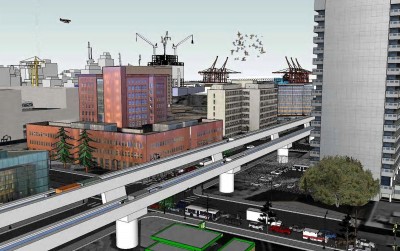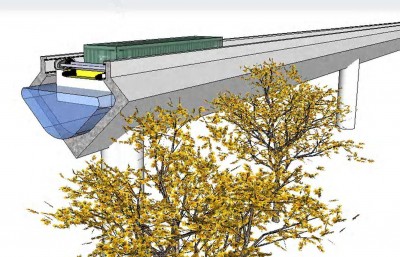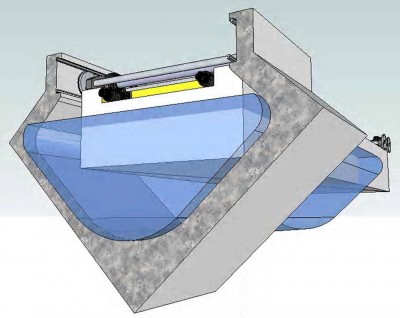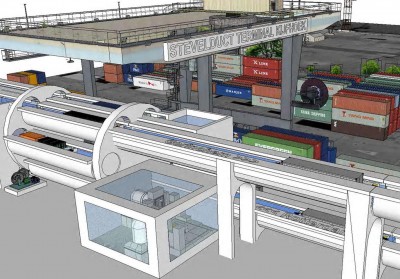Emissions-Free Transport: Containers and the Stevelduct
Posted by Aad van den Ende in Transport 9 Comments» A Dilemma of Economic Growt: How can economic growth in the area of transportation be managed in a manner consistent with the moderation or reduction in the rate of climate change? After all, it is a given that economic growth will require a greater capacity to transport and an intensification in the use of existing infrastructure. With transportation options currently available, it does not appear to be feasible to make progress on the emissions front merely by making greater use of the infrastructure now in place. Unless real alternatives are developed, this state of affairs will continue far into the future. Apparently an insoluble dilemma. The STEVELDUCT offers a solution: it is an emissions free form of container transportation. Given universal standardization as regards containers, it also lends itself to innovation world wide.
A Dilemma of Economic Growt: How can economic growth in the area of transportation be managed in a manner consistent with the moderation or reduction in the rate of climate change? After all, it is a given that economic growth will require a greater capacity to transport and an intensification in the use of existing infrastructure. With transportation options currently available, it does not appear to be feasible to make progress on the emissions front merely by making greater use of the infrastructure now in place. Unless real alternatives are developed, this state of affairs will continue far into the future. Apparently an insoluble dilemma. The STEVELDUCT offers a solution: it is an emissions free form of container transportation. Given universal standardization as regards containers, it also lends itself to innovation world wide.
Stevelen
The STEVELDUCT is, in essence, a simple concept. It envisions freight containers placed in unmanned barges that are transported in an aquaduct, that is to say, a dedicated channel that can be built above or below ground. The barges move along with the water current in the channel as well as by way of an ancient technique that the Dutch called “stevelen.”
Stevelen is a technique that has fallen out of use. It was a method of water transport by which a ship without any other source of power made use of the force of gravity to sail down a stream or a river. It is a natural phenomenon that eventually the ship will sail faster than the current it is drifting on. The reason for this is the fact that a flowing water surface is in fact an inclined plane.
Stevelen can be most easily compared to what happens to an automobile parked on a slope without the benefit of the handbrake. The automobile is likely to star rolling downhill. In some train marshalling yards, a variation of stevelen is still in use: namely by allowing railcars to coast to their destinations.
There is a long history of stevelen on the world’s great rivers. It remains the most environmentally friendly form of transport, because of all of the methods of transportation, it requires the least amount of energy. However, it is no longer allowed due to the congestion of marine traffic. However, the STEVELDUCT will enable this form of transport to be revived.
Aquaduct
The current in a STEVELDUCT is occasioned by a drop in elevation along the length of the construction , as in the well known Roman aqueducts. For example, Le Pont du Gard transported 35,000 cubic metres of water per day from the mountains to the city of Nimes with a drop in elevation of only 28 centimetres for every kilometre in length. Imagine a paper boat launched in the aquaduct. Without any additional input in energy, it can be expected to sail to the end of the aquaduct, simply and cheaply. The same principle can be expected to apply to containers set in barges. Sometimes a combination of simplicity, efficiency, and ancient technique can result in unanticipated innovation.
Barges With the Wheels on Top
The barges are fitted with wheels which are designed to run in grooves built into the side of the STEVELDUCT. Unloaded, the barges are prevented from drifting, rolling, swerving by virtue of the fact that their buoyancy applies an upward pressure on the axles and wheels. By that, the rolling resistance is inversely proportional to the load in the barge. Indeed, rolling resistance is least under maximum load.
Capacity
It is contemplated that a barge will be “launched” in the STEVELDUCT every 30 seconds at any transfer station. This means that there will be 2880 containers in transit in each stage of the STEVELDUCT. Apart from the necessary handling at subsequent transfer stations, there is no impediment to their transport to their destination. Each day, an entire ship’s cargo can be delivered inland and vice versa. It is a supremely practical method of transport. And it is profitable. Multiply each delivered containers by the sum of 100 Euro, and some idea of the financial viability of the scheme cab be arrived at.
The number of containers involved would otherwise require in the order of 7 fully loaded inland waterways container ships. Apart from the economics, the STEVELDUCT operates without noise, vibration, air pollution or particulate matter, and, above all, no CO2
Zero Emissions
The transportation of a single 40 foot container from the new Maasvlakte to Duisberg involves a road trip of about 250 kilometres. Assuming that the transport truck will travel 5 kilometres per litre of diesel fuel, this single journey will require 50 litres of diesel fuel. CO2 emissions amount to about 3.2 kilogram of CO2 per litre of diesel fuel, using the well to wheel calculation. Assume that the truck will travel an average of 50 kilometres per hour. It will take 5 hours to make the trip. The STEVELDUCT has a capacity to launch 120 containers per hour in two directions. In that same 5 hours, therefore, one would expect to see a total of 1200 containers sent under way. Multiply the 160 kilograms of CO2 by 1200 containers and the result is 192,000 kilograms or 192 tonnes of CO2. For one 24 hour period, the math works out to 240 containers per hour, 24 hours or 921.6 tonnes of CO2 which works out to 336,384 tonnes of CO2 per year.

A Stevelduct through an urban area
Now, it is true that pumping systems and transfer stations will require energy inputs, but these are fixed installations and can thus operate by electricity generated in low carbon or carbon neutral ways. That is not an option for shipping by inland waterway or by road. In addition, it is foreseeably easier to argue for building a STEVELDUCT through an urban area than a highway or a shipping channel.
Giving Back to the Environment
Those portions of the STEVELDUCT that are built above ground can be constructed such that flora and fauna can flourish. The vertical pillars can be adapted to attract and house bats and birds and bees. The entire construction lends itself to be overgrown with vegetation. Quite apart from that, C2C construction methodology will be employed and surplus industrial heat will be used to prevent freezing in times of cold weather. All this, in addition to the emissions-free character of the STEVELDUCT provides for a great surplus in environmental compensation that can be credited to other civic works for which no such compensations can presently be designed.
Getting Serious
The STEVELDUCT started as a whimsical submission in the Zuid-Holland Prize 2010 accompanied by a curiosity to see how far one could get with a zero budget and a bit of imagination. I was curious to see whether this would open any doors, who I would get to talk to, whether or not any sort of commercial interest would develop, and, above all, whether the concept could actually be made to work. Would this idea fall by the wayside, or would it generate some enthusiasm and interest? At the moment, the latter appears to be the case.
Aad van den Ende, Initiator Stevelduct concept








9 replies on “Emissions-Free Transport: Containers and the Stevelduct”
It’s like a railroad but less efficient! There’s no analysis of friction in the article, but since water is a lot thicker than air, I’d be stunned if the friction acting on the containers at any useful speed (10mph?) would be less than for an equivalent railroad car. Back to the drawing board I imagine…
@Owen,
The system works by pumping the water into the duct. The water then travels through the duct and pushes hundreds of containers along the duct. In this case the friction of the water and the containers is pushing them forwards. The only energy which need to be invested is pumping the water into the duct.
It’s similar to a railroad, but less efficient! The article doesn’t discuss friction, but given that water is much denser than air, I’d be surprised if the friction on the containers at any reasonable speed (like 10 mph) is less than that of a regular railroad car. I guess it’s back to the drawing board!
It’s like a railroad, but less efficient! The article doesn’t analyze friction, but since water is much denser than air, I’d be surprised if the friction on the containers at any useful speed (like 10 mph) is less than that of a railroad car. Looks like it’s back to the drawing board!
It’s similar to a railroad, but less efficient! The article doesn’t account for friction, but considering that water is much denser than air, I’d be surprised if the friction on the containers at speeds as low as 10 mph is any less than that of a railroad car. Looks like it’s back to the drawing board!
It’s similar to a railroad, but less efficient! The article doesn’t account for friction, but considering that water is much denser than air, I’d be surprised if the friction on the containers at speeds as low as 10 mph is any less than that of a railroad car. Looks like it’s back to the drawing board!
Wow! I’m truly impressed by how thoroughly you explained everything. The post is highly informative, and it’s clear you’re very knowledgeable in this field. Thank you for sharing such an incredible piece with us!
Thank you for this incredible blog post! We truly appreciate the valuable insights you’ve shared. It’s packed with helpful ideas and approaches that will surely inspire and guide readers.
I appreciate this amazing article post. We sincerely value the insightful information you have provided. It is full of practical suggestions and methods that will undoubtedly motivate and direct readers.